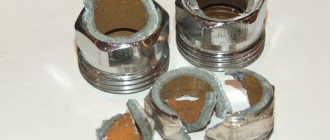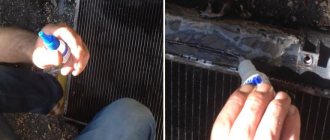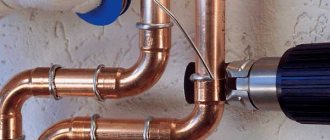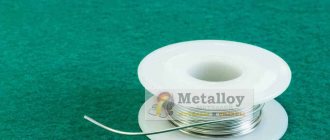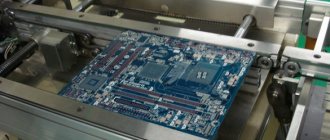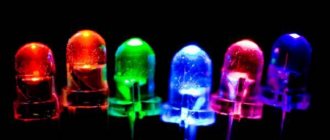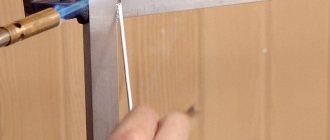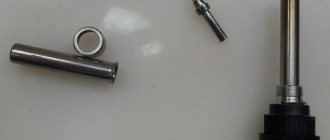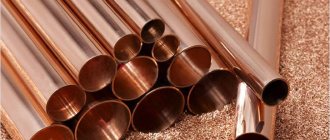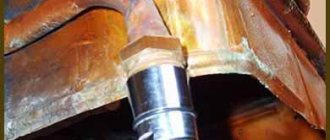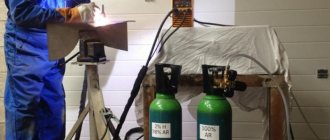Tools and accessories for hard soldering:
The essence of hard soldering is the use of refractory solders and higher temperatures.
The soldering iron is no longer suitable for hard soldering, as it produces too little heat. Of course, it can be used for small things - but it should be the most powerful. Large objects are soldered on hot coal, the heat of which is maintained by a blower; when soldering not very large objects, fur can be successfully replaced with a fan made from goose feathers.
Hard coal is cheaper, but its sulfur content makes it unsuitable for iron and steel; and in general it should be used carefully and only by an experienced solderer, and it is not very convenient at home. For the same reason, illuminating gas is not suitable for iron and steel.
Charcoal (made from dense wood) is therefore preferable to any other fuel, especially for hobbyists. For soldering, ordinary forges are used; Portable forges are very convenient for this purpose, one of which is one of the examples.
Advantages of soft and semi-hard solders
The main areas of application for soft and semi-hard solders are the following:
- POS63 – for soldering collectors, sectional armatures, windings with H insulation of an electrical machine.
- POS61; POSSu61-0.5 and POS61M are necessary for soldering copper elements and its alloys, as well as silver and nickel parts and conductive parts of an electric machine, with operating temperatures up to one hundred and sixty degrees Celsius.
- POS40 and POSSU40-0.5 - are intended for soldering copper elements and its alloys, as well as steel and metals with tin, silver or nickel coating, collector bands and sectional armatures of machines that come into contact with salty liquid (for example, sea water ).
- POSSUZO-0.5 - in order to solder copper elements and its alloys, as well as elements made of iron and stainless steel, as well as soldering cables, bandages, parts of devices that will operate at temperatures up to one hundred and sixty degrees Celsius.
- POSK50-18 - in order to solder copper elements and its alloys that can withstand overheating, as well as soldering parts made of aluminum and copper, ceramic, glass and plastic parts with the addition of tin, silver, nickel components.
- POS10 and POSSu18-0.5 – for soldering contact surfaces of electrical devices, relays and other machine components.
- P0SSu95-5 and PSrZKd - for soldering collectors, sectional armatures, bandages and conductive connections of pipelines and electrical equipment.
- POSIZO and PSrZI - are designed to solder copper elements and its alloys, parts made of non-metallic materials and glass. They have high fluidity and provide a reliable connection of parts during soldering.
Antimony solders are not intended for use in soldering parts containing zinc or galvanized steel.
Solders:
There are many hard solders, but you should choose between them those that are suitable for the given metals - by color, melting point and affinity.
The melting temperature of the solder should perhaps be closer to the melting temperature of the metals being soldered, BUT! a few degrees lower! otherwise, during soldering, the metals being soldered may melt.
Here are some solders for copper, iron, brass, steel and bronze in descending order of their fusibility:
A) 2 parts copper and 1 part zinc;
B) 5 parts of good brass and 1 part of zinc;
C) 1 part copper and 1 part zinc (this solder is known as copper or strong solder); all three are for soldering copper or iron;
D) 16 parts of copper, 1 part of zinc and 1.5 parts of tin;
D) 13 parts of copper and 11 parts of pure silver;
E) 1 part copper, 1 part brass and 19 parts pure silver;
G) 5 parts brass, 5 parts zinc and 5 parts pure silver; The last four solders are for brass, but solder “E” also solders steel very well.
For copper (red) and iron, brass can serve as a good solder, and iron, in addition, can be easily soldered with pure red copper.
Guidelines for performing practical work “Soldering with soft and hard solders”
| Section 2 | Locksmith operations |
| 20 | Soldering with soft and hard solders |
Goal of the work:
get acquainted with the technological processes of soldering parts with soft and hard solders. Acquire the skills of conventional representation and symbolic designation on assembly drawings of seams in joints of parts by soldering. Read the technical requirements and indicate the brand of solder.
Guidelines
:
1. Study the technology of soldering with soft and hard solders
2. Study the types of solders and soldered seams.
3. Learn techniques for making soldered seams.
Theoretical material
Soldering
- joining parts in a solid heated state using a molten intermediate filler material called solder.
You can solder carbon, alloy and stainless steels, non-ferrous metals and their alloys. Advantages of soldering:
slight heating of the parts being connected, which preserves the structure and mechanical properties of the metal; maintaining the dimensions and shapes of the part; connection strength.
Soldering is used in the manufacture of blades and disks of turbines, pipelines, radiators, fins of air-cooled engines, bicycle frames, industrial vessels, gas equipment, a method of connecting parts in the electrical, radio, television and other industries.
There are two types of soldering:
1) soldering with soft solders, if the melting temperature of the solder does not exceed 400 0C;
2) soldering with hard solders, if the melting temperature of the solder is above 400 0C.
The mechanical strength of soldered seams when soldering with soft solders is 50-70 MPa, and when soldering with hard solders - about 400 MPa. Heating during soldering can be carried out with soldering irons, burners, in furnaces, high-frequency frequencies, by contact method, as well as by dipping parts into molten solder.
Solders
must have the following properties: melting material; in the molten state, the solder should wet the material being soldered and spread over its surface; ensure high adhesion, strength, ductility and tightness of the solder joint; have a coefficient of thermal expansion close to the coefficient of the soldered material.
Soldering with fusible solders is used in cases where it is impossible to heat the metal to a high temperature, as well as when there are low demands on the strength of the soldered joint. Connections soldered with low-melting solders are quite airtight.
Depending on the melting point, there are particularly low-melting (up to 145 °C), soft or low-melting (up to 400 °C), and hard or refractory (over 1850 °C) solders. Based on the main component, solders are divided into tin (PO), tin-lead (POS), zinc (PC), copper-zinc (brass, PMC), silver (PSr) and others.
They produce solders in the form of wire (Prv), rods (Pt), tapes (L), etc.
For plumbing work, POS 40 solder is most often used.
When soldering with hard solders the following are used:
1) pure electrolytic copper of grades M1 and M2, Tm = 1083 0C for steels and hard alloys:
2) copper-zinc solders Tm = 845-900 0C for soldering ferrous and non-ferrous metals:
- PMC-36 for soldering brass containing 60 - 68% copper,
- PMC-48 - for soldering copper alloys containing copper over 68%;
- PMC-54 - for soldering bronze, copper, tombac and steel.
3) silver solders (PSr-72, PSr-52, PSr-25, etc.), Tm = 635-870 0C for soldering ferrous and non-ferrous metals, provide high-quality seams and other solders.
Standardized solders (selective option)
| Solder name | Solder grade | Approximate purpose for soldering... |
| Tin-lead | POS 40 | electrical equipment, parts made of galvanized iron with sealed seams |
| POS 61 | radio equipment, printed circuit boards, precision instruments | |
| POS 10 | and tinning of contact surfaces of devices | |
| Copper-zinc | POSK 50-18 | parts sensitive to overheating, for step soldering of capacitors |
| PMC 54 | copper, copper alloys and steel | |
| Silver | PSR 10 | various parts |
| PSr 71, PSr62, PSr40 | radio products, connectors, boards, etc. |
Fluxes for soldering are substances of organic and inorganic origin intended for:
- removing oxides from the surface for soldering,
- improve the conditions for wetting the surface of the soldered metal with molten solder, reducing surface tension,
- improves the flow of liquid solder
protection from environmental influences.
Fluxes must satisfy the following basic requirements:
- the melting point of the flux and its specific gravity must be lower than the melting point and specific gravity of the solder,
- completely melt and have good fluidity at the soldering temperature, but should not be too fluid so as not to “leave” from the soldering point,
- must completely and quickly dissolve the oxides of the base metal and must not form compounds with the base metal and solder, nor be absorbed by them,
- should cover the surface of the base metal at the soldering site with a uniform layer, protecting it from oxidation
- the adhesion force between the flux and the base metal must be weaker than the adhesion force between the solder and the base metal,
- should not evaporate or burn out at soldering temperature, and its decomposition products and oxides should be displaced by solder, easily removed after soldering and not cause corrosion.
The following materials are used as fluxes for soft soldering:
1) zinc chloride (30% solution of zinc chloride in water) for soldering ferrous and non-ferrous metals except zinc and aluminum and its alloys;
2) natural rosin for soldering assembly connections of copper and its alloys;
3) a paste consisting of rosin, zinc chloride and petroleum jelly, for soldering ferrous and non-ferrous metals, for stainless and heat-resistant steels, gray cast iron.
The following compositions are used as fluxes for hard soldering:
1) for steels and copper alloys, borax is used in the form of powder, paste or a mixture of borax and boric acid (when using copper solders);
2) for hard alloy plates with silver solders, a flux consisting of 43% potassium fluoride and 57% boric acid is used;
3) for aluminum plates with aluminum solders, a flux consisting of 25-35% lithium chloride, 12-18% potassium fluoride, 18-15% zinc chloride and 59% potassium chloride is used.
Soldering with soft and hard solders is performed in almost the same sequence:
- soldered surfaces are cleaned of dirt, corrosion crusts, etc.;
- cleaned until shiny, i.e. until there are no visible traces of oxides;
- coated with flux - a substance that removes oxide residues and prevents oxidation of surfaces in the further process;
- then the surfaces are tinned - molten solder (an alloy specially designed for soldering) is applied to them, while it spreads into a thin film and chemically combines with the base metal;
- the parts are pre-connected mechanically: by twisting, compression with tweezers, pliers, in a vice, clamp, etc.;
- additional flux is applied to prevent oxidation of the solder under heat;
- More solder (perhaps a different one) is applied with heating until a junction of the specified quality is obtained.
Tinning -
coating the surface of metal products with a thin layer of a metal alloy (tin, tin-lead alloy, etc.). The applied layer is called half-layer and tinning is used when preparing parts for soldering, as well as to protect products from corrosion and oxidation.
U
verbal images and designations for connecting parts by soldering are established by GOST 2.313–82.
Soldered seams in views and sections are depicted as a solid thick line approximately twice as thick as the visible contour lines used in the drawing. A symbol of soldering is placed on the leader line - a semicircle made by a solid main line. For a visible seam, the leader line starts on both sides
with an arrow resting on the image of the seam. If the seam is invisible (covered by the image of the part being soldered), then the leader line does not have an arrow and points to the surface of the part being soldered. To indicate a seam made along a closed line, a sign is used - a circle with a diameter of 3...5 mm, drawn as a solid thin line at the end of the leader line. In the image of the soldered joint, if necessary, indicate the dimensions of the seam and the designation of the surface roughness.
| PV-1, PV-2, … | butt | |||
| PN-1, PN-2, … | Overlapping | |||
| PU-1, PU-2, ... | Angular | PS-1, PS-2, ... | touching | |
| PT-1, PT-2, … | Tavrovy | |||
Electric soldering iron
1 — handle, 2 — steel plug, 3 — clamps, 4 — heating element, 5 — overhead sides, 6 — cord, 7 — plug, 8 — copper rod
Completing of the work
- D
The definition of "SOLDING" is... - Define "TINING" as...
- Specify the name of the soldered seams
- The assignment contains a drawing of the assembly unit. The products shown in the assembly drawings consist of individual parts. Indicate the name of the soldered seam. Choose a brand of solder if the material of the parts is.... Conventionally depict solder seams on the drawing of the assembly unit in accordance with GOST 2.313–82
Option 1 (material - steel)
Option 2 (material - brass L62)
Option 3 (material - bronze)
Option 4 (material - tompak)
Option 5 (material - steel)
Option 6 (material - brass L62)
Option 7 (material - bronze)
Option 8 (material - tompak)
Option 9 (material - steel)
Option 10 (material - brass L62)
- Indicate the design of an electric soldering iron and describe the basic safety requirements for working with it
Control questions
- What is soldering? The difference between soldering and welding.
- How to prepare a product for soft soldering?
- What soft solders and fluxes are used for soldering steel parts?
- How and with what is soft soldering performed?
- How is brazing performed?
- What is tinning and how is it done?
- What labor safety requirements must be observed when soldering with soft and hard solders?
- What is solder? Difference between hard solders and soft solders.
- Purpose of fluxes?
- What is the sequence of operations when soldering?
Brazing methods:
During soldering, the pieces to be soldered must, of course, be fixedly connected to each other and, if possible, placed on a solid, stationary support, which can be a piece of hard coal, a refractory brick, a piece of pumice, etc. Some things, such as rings, can be held over the fire by the end of the wire connecting them. It is better to avoid holding objects to be soldered with pliers, since pliers take away a lot of heat.
Read also: Reasons for inverter welding machine not working
It is very convenient to solder small things on an artificial bedding prepared as follows: hollow out a recess in the refractory brick in the form shown, fill the recess with a dense dough of 2 parts (by volume) of fine charcoal powder and 1 part of finely ground refractory (or porcelain) clay, carefully mixed first with each other and then with gruel made from 1 tablespoon of rice flour
Hard soldering of large objects:
Hard soldering of large objects requires, first of all, their connection with the strongest possible seam. The most suitable seam is a “seam-to-seam”, which binds even more firmly, but it loses too much material, as a result of which the strength of the parts being connected can be greatly reduced. There is also a so-called serrated seam - convenient for soldering pipes and cylindrical parts in general. In some cases, any other types of seams may be useful. And here, as with soldering in general, the more accurately and tightly the seams are fitted, the stronger the connection.
One or two thin rivets can significantly contribute to the connection and fastening of the seam, but you must be careful with them - not to make them larger or thicker than the thickness and other parameters of the soldered products allow.
PS: I tried to clearly show and describe non-tricky tips. I hope that at least something is useful to you. But this is not everything that can be imagined, so go ahead and study the site https://bip-mip.com/
- Soft solderingSoft or weak soldering is called: soldering using soft, or.
- Soldering general rules Soldering (soldering) is an operation by which more or less is performed.
- Chemical painting of metalIt is often necessary to apply durable and indelible inscriptions or drawings on.
- Powder for cleaning metals We all know about the benefits of chemicals in everyday life.
- Gluing plexiglassGluing plexiglass parts is a fairly common operation during work.
Soldering stainless steel is a rather labor-intensive process, but at the same time there are no great difficulties here. Alloys containing up to 25% nickel and chromium are alloyed together quite simply. Moreover, these alloys can create strong bonds with other metals, with the only exceptions being magnesium and aluminum alloys.
But you need to pay attention to the fact that some nickel-plated alloys when heated to a temperature of 500-700 degrees. Carbides can form; their level of release depends on the duration of soldering, so the procedure time must be reduced.
The resulting carbides significantly reduce the corrosion resistance of stainless steel. In order to minimize the precipitation of carbides, titanium is added or additional heat treatment is carried out upon completion of soldering. Under the influence of hot solder (tinol), the cold-hardened stainless material can crack, so soldering occurs after annealing, without using loads during soldering.
The choice of solder for stainless steel depends entirely on the following characteristics: steel composition, soldering conditions. It should be noted that products that are made in corrosive conditions must be soldered using silver tinols, which contain a small amount of nickel in the composition. Copper, silver-manganese, and chromium-nickel solders are used during oven soldering in dry conditions.
is most often used as a flux for processing stainless steel . It is applied to the joint in powder or paste form. When the borax melts, the rest of the metal gradually heats up to a bright red heat (850 degrees). When this temperature is reached, solder is injected into the joint.
Removal of material adhering to the stainless surface upon completion of soldering is done by rinsing the soldered product in water or by sand blowing. Hydrochloric or nitric acid, which can be used in cleaning, are very undesirable at this stage of working with stainless steel, since they, along with the solder, will corrode the base metal.
Brazing stainless steel - Metals, equipment, instructions
Sometimes brazing stainless steel is preferable to welding. Soldering is used for thin-walled products that are not subject to heavy loads, and in cases where they do not want to experience warping from heating.
It should be taken into account that some types of stainless steel require a certain approach, taking into account their composition and manufacturing technology. For example, cold-worked stainless alloys crack at high temperatures, so their soldering is carried out without loads, after first annealing the metal. There are other subtleties.
Features of alloys
Stainless steel cannot be soldered with aluminum and magnesium alloys. With other metals the process goes well, while the joint itself is characterized by increased strength.
Some stainless steel alloys, especially those containing more than 25% nickel, begin to release carbides at temperatures of +500-700 ℃. These chemical compounds reduce the corrosion resistance of the metal.
And the longer the soldering process at this temperature, the more intense the carbides are released. Therefore, soldering time must be reduced. Soldering at home is carried out with a soldering iron or a gas torch, and a soldering iron is used more often.
Solder selection
There are two factors influencing the choice of solder for stainless steel:
- the conditions under which the connection process is carried out;
- stainless steel composition.
If you have to work under normal conditions (in any room), then it is better to solder with silver solder, which contains a small amount of nickel.
When carrying out the soldering process in a furnace, that is, in the complete absence of humidity, copper, silver-manganese or chromium-nickel solders are used.
It should be noted that silver-based hard solders are the best option for soldering stainless steel parts.
After all, silver is also resistant to corrosion and has the same light color as stainless steel. But it should be noted that pure silver is not used in solders.
Zinc or copper is added to the alloy. The higher the percentage of silver, the higher the quality of the alloy. True, such material will have to be used at higher temperatures. Tin solders are rarely used when high strength is not required.
Table 1. Composition and properties of silver solders
| Solder test | components, % | Temperature, °C | ||||
| Silver | Copper | Zinc | Cadmium | Start of melting | Complete meltdown | |
| PSr-80 | 80,0 | 12,4 | 7,6 | — | 780 | 800 |
| PSr-75 | 75,0 | 18,6 | 6,4 | — | 755 | 755 |
| PSr-70 | 70,0 | 30,0 | — | — | 770 | 780 |
| PSr-70 | 70,0 | 26,4 | 3,6 | — | 745 | 765 |
| PSr-65 | 65,0 | 35,0 | — | — | 790 | 810 |
| PSr-65 | 65,0 | 20,0 | 15,0 | — | 700 | 720 |
| PSr-60 | 60,0 | 24,8 | 15,2 | — | 700 | 720 |
| PSr-50 | 50,0 | 50,0 | — | — | 779 | 850 |
| PSr-50K | 50,0 | 16,0 | 16,0 | 18,0 | 650 | 670 |
| PSr-45 | 45,0 | 30,0 | 25,0 | — | 660 | 725 |
| PSr-25 | 25,0 | 40,0 | 35,0 | — | 745 | 775 |
| PSr-12M | 12,0 | 52,0 | 36,0 | — | 780 | 825 |
| PSr-10 | 10,0 | 53,0 | 37,0 | — | 815 | 850 |
Flux selection
As for flux for soldering stainless steel, the best option here is borax. It can be used in paste or powder form. Borax powder is poured into the soldering zone of two workpieces and heated to a temperature of +850 ℃. This is the so-called light red heat temperature.
Once the flux has melted, solder is added to the area. If you follow the standards, then to work with silver solders, use flux No. 209 or 284 according to GOST, and for solders containing copper and nickel - No. 200 or 201.
Remains of flux after soldering are removed with water (cold or hot) or blown with sand. It is not recommended to use hydrochloric or nitric acid for this. This is a potent material that corrodes the solder layer and the stainless steel itself.
How to solder correctly at home
In order to properly solder two stainless steel workpieces together, you need to properly prepare for the process. To do this, it is better to use orthophosphoric acid or zinc chloride, which is usually called soldering acid, as a flux. A soldering iron needs a power of 100 W. As for solder, it is easier to solder stainless steel with tin at home.
The first stage of the process is to clean the edges of the two stainless steel parts. To do this, use sandpaper or a file with fine notches. Then you need to tinning the prepared edges.
To do this, the planes to be joined are treated with flux, then the solder is heated with a soldering iron, which is applied to the ends of the two workpieces. The solder should remain on the soldering iron tip, and from it should be transferred to the planes that are to be tinned.
If the tin does not stick to the stainless steel, then the procedure must be repeated, preheating the ends of the parts to be connected.
Once tinning has occurred, you can proceed to soldering by adding flux and solder to the joint area. At the end of the process, the acid is washed off with water.
Connection with other metals
The connection of two different metals, for example, the soldering of copper and stainless steel, must be approached from the position of studying their properties. Metals have different melting points, so the soldering process is considered one of the most difficult.
Joining copper and stainless steel at home includes processing the workpieces, tinning the edges and the soldering process itself.
It should be noted that copper and stainless steel can be soldered with a soldering iron or torch. The first tool is low-power, so it cannot work with hard solders.
The soldering iron is also not used for soldering large contact areas due to the length of the process. In addition, the flux will oxidize even before it has time to fully warm up.
A burner is the best option. With its help you can solder not only stainless steel with copper, but also with brass.
By the way, when choosing solder, you need to pay attention to brass rods. It is primarily the most common material for soldering stainless steel and can even be used in a joint without flux.
It should be taken into account that brass is inferior to silver in many respects. But it is cheaper. It should only be used for soldering simple non-critical connections.
The process of soldering copper or brass to stainless steel is no different from others. It is necessary to clean the edges of the two metals, degrease them, and tinning each edge separately.
Soldering stainless steel at home
Perhaps everyone knows that a home handyman is constantly faced with everyday difficulties that he needs to eliminate on his own. But it often happens that you need to do the work associated with processing stainless steel yourself. Therefore, this will require certain skills, abilities and knowledge. You will also need to acquire some materials and tools. Here is a list of everything you need:
- Soldering acid;
- Electric soldering iron 100 Watt;
- Tin solder for joining metals;
- File or sandpaper;
- A tube;
- Metal cable.
Now that you have decided on the soldering tool, you need to know the steps to perform the actions:
- To process stainless steel, you must initially ensure that you have flux and a 100-watt electric soldering iron. You need to know that there is no point in choosing a more powerful soldering iron for processing stainless steel. The flux is ordinary soldering acid. Also, do not forget to always have tin-lead solder on hand.
- When all the necessary tools and materials are ready for soldering, you can begin work. First you need to clean the stainless steel joint: this can be done using sandpaper or a file. Upon completion of cleaning the work areas, it is necessary to apply soldering acid followed by further treatment. If the treatment does not work (the solder does not stick to the surface of the stainless steel), then you need to re-manipulate the soldering acid on a thoroughly heated surface, then perform the treatment again.
- In the case when you made a second attempt, and it was not successful, and the solder lags behind again, then the working surface of the stainless steel needs to be cleaned with a special brush, which you can make your own: you will need a piece of pipe with a cross-section of 5 mm, where you place thin wires pulled from a metal cable . Now, apply acid to the soldering area, and then bring the brush and soldering iron here at the same time. Then start working with two tools. It should be noted that this process is very helpful in removing the oxide film from the surface of stainless steel.
- When the parts have been tinned, begin soldering stainless steel using a soldering iron and flux.
Read also: Schematic diagram of a stepper motor
Soldering stainless steel: what do you need to know about the procedure? — Welding
Soldering stainless steel is a very labor-intensive process. By following the soldering technology and taking into account all the features, this procedure is greatly simplified.
Stainless steel metals such as nickel and chromium with a metal content of no more than 25% are relatively easy to process.
Such materials make it possible to obtain high quality soldered joints even from dissimilar metal parts with the exception of aluminum and magnesium alloys. The most technologically simple processes include soldering stainless steel with tin.
Features of soldering stainless steel
The use of tin solders is excellent for soldering small items, as well as repairs at home. Without any problems, you can solder a saucepan, bowl, mug or other household items made of stainless steel at home using a regular electric soldering iron and tin.
For particularly critical solder joints, special grade alloys based on phosphorus and nickel are used. In addition, materials from chromium, nickel, and manganese are widely used.
This group is well suited for working in gases containing a mixture of boron trifluoride and argon.
In this type of soldering, the solder can be copper in its pure form, which is excellent at wetting the metal, followed by a strong connection.
Before soldering stainless steel, it is recommended to familiarize yourself with the technological process, as well as the features of different methods of working with metal.
By watching the corresponding video, you can get detailed information about all the features of the working procedure.
Soldering a variety of products made from food and industrial stainless steel has many nuances that you pay attention to when choosing a soldering method, as well as the consumables required for this.
Equipment used
Correct work with stainless steel items requires theoretical training and familiarization with the process itself through video materials. To solder stainless metal at home, the following equipment and materials are used:
- electric soldering iron about 100 W or a gas burner;
- flux for soldering stainless steel in the form of a special soldering acid;
- sandpaper, wire brush or file;
- solvent (acetone);
- solder;
- protective gloves and cleaning cloth.
In addition to basic tools and materials, additional accessories may be needed depending on the type of part being processed. Soldering large-sized products may require the use of a higher-power electric soldering iron. This is necessary for good heating of the joints.
Soldering with a gas torch
The parts are heated using a gas torch or a tin-plated soldering iron tip. When working with the burner, you must ensure that there is not too much oxygen in the flame, because this causes the stainless steel to oxidize. This can be determined by the color of the fire (it should be blue); if the color is pale and the fire is weak, then this indicates an excess of oxygen. To warm up the connection, the burner must be moved smoothly.
By periodically touching the metal with solder, the quality of the temperature achieved is determined. Heating is sufficient when the solder melts not from the flame of the torch, but from touching the metal.
Then solder is immediately applied to the part where the joint needs to be made, while the parts continue to be heated so that the solder, melting, slowly fills the joint completely . If there is not enough liquid solder in some area, it is heated more strongly than other places, and the solder itself flows into it. A clear sign of high-quality soldering is the leakage of excess solder from the joint.
Flame soldering
It is advisable to use soft soldering using a flame in cases where it is necessary to connect relatively thick or large parts. You can heat them with a flame faster and more evenly than with a soldering iron.
Almost all metals and their alloys are suitable for soft soldering. Do not solder light metals such as aluminum. There are solders designed for specific materials or for joining different metals. Before purchasing solder, ask the seller which one is best suited for the material and connection method you have chosen.
The main condition for a reliable solder connection is the cleanliness of the contact surfaces. Anti-corrosion grease or foreign deposits remaining on the surfaces are burned off with a flame. However, due to the relatively low temperature when soldering with soft solder (180-400°C), this is not always achieved. Therefore, only decorative joints can be butt soldered, since they do not experience heavy loads. If there are mechanical loads, they should be overlapped.
Precautionary measures
When carrying out soldering work, ensure good ventilation of the room. The fact is that solder, which contains heavy metals, emits toxic fumes when heated and melted. They, like the fumes from heated flux, are harmful to health. Soldering should be done with safety glasses and at a safe distance from flammable materials.
It is better to pre-fix such a corner butt joint with wire clamps: this will make it easier to solder the continuous seam.
Working with hard solders
Stainless steel soldering works well using flowable, liquid, fluxed solder with a low melting point and high capillary characteristics. This solder is quite elastic and has excellent deoxidation properties, which are very useful when working with stainless steel.
It can also handle brass, copper and some other materials. Soldering with such hard solders is very suitable for stainless steel. Stainless steel does not contain cadmium, and the percentage of silver here is 30%. Processing the material with hard solders gives good results, making it possible to obtain durable and high-quality metal fastening.
HTS528 solder can cope with copper, brass, nickel, bronze, stainless steel, and other metals. Along with other hard solders today, this tinol is the most in demand. The solder looks like a rod treated with red flux. The rod size is about 45 cm , and the weight is 20 g.
The melting point is 760 degrees.
Where is it used?
Brazing is notable for the fact that when it is carried out, the area where the products are joined must be heated to temperatures of about 450 degrees or more.
Such solders are called refractory, and the joint obtained with their help retains its strength characteristics even with strong thermal heating.
Unlike hard soldering, soft soldering involves the use of low-temperature consumables, which provide reliable adhesion at significantly lower heat (about 200-300 ℃).
They are, as a rule, used when soldering products operated under normal temperature conditions, and do not guarantee the preservation of contact under high heat.
The capabilities of hard solders are widely used in those areas where it is necessary to obtain a seam whose strength properties occupy an intermediate position between welding and low-temperature soldering.
In this case, special attention is paid to preserving the structure of materials in the contact zone, which after processing should not lose their original characteristics.
Carbide compounds are most often in demand in the following situations:
- production of metal-cutting tools, cutters with carbide working inserts;
- in the manufacture of containers and vessels made from non-ferrous metals and stainless steel;
- in auto repair shops (when repairing radiators and individual transmission elements), as well as in those places where the use of welding is extremely undesirable;
- during installation and repair of tubes made of hard copper alloys installed in refrigeration and heat exchange equipment and operating under conditions of “critical” temperatures or high pressure;
- for reliable and durable connection of thin-walled objects and parts that experience increased loads and elastic deformations during operation.
The use of hard soldering technology ensures the necessary strength of the resulting connection and its resistance to overheating. In addition, carbide methods are used in the repair of copper or brass products that are exposed to high temperatures during operation.
Unlike the hard solders described above, the scope of application of soft soldering is limited to normal operating conditions. This method is most often used when it is necessary to obtain a reliable connection of products and parts made of low-melting materials that are not subject to excessive heating and deformation.
Widespread tin-lead soldering compounds are especially popular for “soft” jointing of parts.
How to choose a flux for soldering
Small elements are soldered with adjustable gas-air burners (this method is more suitable for jewelry). Larger parts are best soldered with acetylene. The same applies when choosing a flux for stainless steel, since this metal is very demanding on flux. Flux for stainless steel consists of 10% calcium fluoride, 20% boric acid, 70% borax .
For small stainless steel parts, you can prepare a flux composition that includes 50/50% boric acid and borax. This flux must be diluted in water, then applied to the part; when it dries, the solder will adhere perfectly to the metal surface.
That is, the soldering area is not etched, but only cleaned using sandpaper. Copper does not spread well over the surface of steel, so it is better to use L 63 brass. For better soldering, you can also use silver and brass to make solder from them.
Recommendations from professionals
There are many people who, so to speak, “ate the dog” when working with soldering. And they share personal experience gained in practice, giving useful recommendations:
- It is best to choose a soldering iron with a non-burnable tip.
- An electric soldering iron needs a power of 60-100 watts. The most optimal soldering iron is 100 Watt. A less powerful soldering iron will not be able to heat the metal.
- Phosphoric acid works best as a flux.
- It is advisable to use tin-lead rods as solder. You can also use tin in its pure form. It must be said that it is better to solder utensils with tin, since pure tin does not contain lead.
- When working with soldering, it is necessary to use personal protective equipment.
- Soldering must take place in a well-ventilated and open area.
Useful tips
Soldering steel is a labor-intensive process, during which controversial issues may arise. In order not to get hung up on them, you need to take into account the advice and recommendations of other masters:
- An electric soldering iron with a power of 100 W is enough for home repair work. It is advisable to choose a model with a non-burning tip.
- The best type of solder are rods made from an alloy of lead and tin. If you need to repair a crack in a pot, you need to use tin solders.
- The ventilation system will protect the respiratory tract from diseases associated with inhalation of harmful impurities.
You need to practice on spoons, cups and old bowls. You can use waste from the production of galvanized castings.
Basic mistakes during soldering
If an error is made during preparation, selection of materials, or during the soldering process, the solder may not spread over the surface and may not hold the parts together. It happens that the parts were not properly cleaned or were not heated up properly. This often happens with large-sized products. The tip of the soldering iron must be thoroughly cleaned after any session, and in order for jewelry work to be possible, its tip must be sharpened from time to time.
To obtain a high-quality connection, do not solder stainless steel with pure lead or use rosin. If the solder is made of tin, then working with it can be quite difficult due to its weak consistency. If the tin does not melt more than to the state of warm plasticine, then most likely it will not hold the connection, constantly breaking and crumbling. The optimal state of tin for fastening is if it looks like a liquid.
High-quality solder, which is laid according to all the rules, can only be scratched , but not separated from the stainless steel soldering area. In order not to damage the connection in the future, after soldering the product must be allowed to cool down at rest. When the joint has cooled, it is cleaned of any flux and solder that remains at the edges, and then washed thoroughly with soap.
Instructions for soldering steels. Soldering of assembly components with high-temperature solders
Purpose
The instruction is a guide for soldering steels: structural, corrosion-resistant (stainless) and heat-resistant with high-temperature hard silver solders PSr40; PSr MIN63; PSr21.5; and copper solders VPR1; VPR4 and their imported analogues with gas burners, as well as in chamber furnaces and furnaces with a vacuum environment.
Equipment and materials
2.1 Gas burner GOST 1077-79 2.2 Chamber electric furnace with temperatures up to 1300 degrees 2.3 Vacuum oven type START 2.4 Necessary devices for installation and fixation of parts 2.5 Acetone GOST 2603-79 2.6 Pure argon class “A” GOST 10157-79 2.7 Tweezers
SOLDERS AND FLUXING SUBSTANCES
3.1 For soldering, use the solders listed in table.
Solder grade | Soldering temperature °C |
| PSr40 GOST 19738-74 19746-74 | 650-670 |
| PSrMIN63 | 800-820 |
| PSr21.5 | 1080 |
| VPR1 | 1130 |
| VPR4 | 1050 |
3.2 Heat treatment of solder is carried out if appropriate, if the solder is not sufficiently ductile. 3.3 For soldering, use the following types of fluxes: • PV200 for soldering with PSr21.5 and VPR1 solders; • PV201 for PSr40 and PSrMIN63; • Potassium tetrafluoroborate (KVF2) GOST 9532-75 for soldering PSr21.5 and VPR1 in a neutral environment.
Read the article “How to make gumboil with your own hands”
4 PREPARATION OF THE SURFACE OF PARTS AND SOLDER
4.1 The size of the gaps should, as a rule, be from 0.7 to 0.15 mm for telescope-type connections and up to 0.2 mm for other connections (lap, butt, T-joints). It is allowed to reduce the gap in a telescope-type connection if this is caused by the design features of the unit. 4.2 Surfaces to be soldered must be brought to a roughness of at least 2.5. 4.3 On cemented products, after removing the copper coating, the surfaces for soldering must be mechanically cleaned to bare metal. 4.4 The presence of a chamfer in the place where the fillet is formed during furnace soldering must be excluded. The edges of the groove in which the part to be soldered is placed must be blunted with a radius of ±0.1 mm. 4.5 Presence of tarnish and corrosion on the soldered surfaces of assemblies after fur. processing is not allowed 4.6 Parts to be soldered must be washed. 4.7 Immediately before soldering, degrease the parts included in the assembly and solder in acetone or another solvent and dry in air for 10-15 minutes. After this procedure, assemble with tweezers or use cotton gloves.
5 PREPARATION OF EQUIPMENT AND FIXTURES
5.1 When soldering in a chamber furnace in argon, the inner surface of the container must be cleared of dirt and cleaned by washing with acetone or another solvent. 5.2 Before loading units for soldering, the vacuum furnace must be cleaned of dirt and oil in accordance with the operating instructions. 5.3 The equipment must be washed in acetone or other solvent before soldering. If there are loose oxide films, it is allowed to blow the equipment with electrocorundum or hydrohoning. 5.4 When soldering in a neutral environment, before launching argon into the furnace, purge the pipeline system with argon. Changing cylinders during the soldering process is prohibited.
6 ASSEMBLY
6.1 Assembly of units should be carried out in devices that ensure the required position of the parts and eliminate stress in the soldering zone. 6.2 Fix the solder on resistance welding machines using a welding gun or welding pliers.
7 SOLDERING
a) Soldering with a gas torch 7.1 Dilute the flux in H2O or alcohol to a paste, then coat the surfaces to be joined. 7.2 Coat the solder with flux diluted in H2O or alcohol and sprinkle with flux powder. During the heating process, it is necessary to ensure that the surface of the metal at the gap is not exposed to flux and, if necessary, add flux powder. 7.3 Heat the soldered area to the temperature indicated in the table above. The temperature during soldering is controlled visually at the beginning of melting of the solder. Heat the connection area evenly along the entire length of the connection, avoiding overheating. When soldering parts with different wall thicknesses, heat the more massive parts first. 7.4 Do not allow the flux to come into contact with the flame for more than 4-5 minutes due to the possibility of it losing its fluxing properties. The optimal heating time for flux when soldering in a gas flame is 20-60 seconds.
7.5 During the soldering process, it is prohibited to subject the assembly to mechanical stress until it has completely cooled.
7.6 If necessary, to protect the inner surface of the pipes from excessive oxidation, apply flux to the inner surface of the pipe or pass argon inside.
When soldering, place the pipe in the joint area, if possible, vertically. The fittings must be at the bottom.
7.7 Cold-worked parts made of steel type 12Х18Н9Т should be annealed before soldering (parts made of pipes after bending)
7.8 Bending pipelines after soldering is not recommended and is absolutely not permitted at a distance of less than 20 mm from the soldering point. Solder beads on the nipple can be filed off.
b) Soldering in a chamber furnace
7.9 Produce in sealed containers with a steel screen cap in an argon atmosphere.
7.10 Fluxes 200, 201, 209 are diluted in water to a paste-like state and applied in a thin layer, then dried for 10-15 minutes. Potassium tetrafluoroborate powder is poured into a container. The amount of flux, temperature, holding time, argon consumption, heating and cooling rates are specified in the technology.
7.12 Temperature control is carried out with a thermocouple inserted inside the container.
The thermocouple hot junction should be placed as close as possible to the surface of the work being soldered.
7.13 Cool the parts under a flow of argon to room temperature. It is allowed to blow the container with compressed air in order to reduce the cooling time.
c) Soldering in a vacuum oven
7.14 Produce primarily in argon.
7.15 Place the assembled unit in the device on the furnace tray, covering it with a cap-screen made of steel type 12Х18Н10Т.
7.16 Soldering in argon is performed according to the following scheme:
- Purge the piping system to the vacuum valve with argon
- Pump out the air from the furnace to the residual pressure specified in the technology. It is allowed to flush the chamber with argon, which consists of the following: pumping out to 10-3 mm Hg. Art., filling with gas and pumping again to the required vacuum.
- Feed argon gas into the furnace chamber. Feed continuously for 8-10 minutes.
- Turn on the heat and perform soldering.
7.18 Temperature control is carried out using a thermocouple with recording on a recorder. The thermocouple hot junction should be placed as close as possible to the surface of the soldered assembly. It is permissible to measure the temperature in the chamber, provided that the experimentally determined temperature difference on the surface of the product and in the chamber is taken into account.
8 REMOVAL OF FLUX RESIDUE
In hot, then in cold running water, followed by blowing with hydrohoning.
9 SEAM CONTROL
9.1 Monitoring the condition of components must be carried out at all stages of the technical process of preparing surfaces, assembling and soldering, introducing flux and solder, and eliminating flux residues after soldering.
9.2 The materials used must be GOST certified or have specifications. Monitor the expiration date of the flux.
9.3 Apply the following types of control:
a) external inspection;
b) radiographic analysis;
c) checking components for strength and tightness;
d) metallography;
9.4 Externally examine 100% of the units using a magnifying glass of 4-7x magnification.
You need to inspect the solder seam and the area of the base metal adjacent to it at a distance of at least 10 mm.
9.5 The seam must be clean, without porosity, cavities, fistulas, missing solders, foreign inclusions, flux residues, etc. provided that the solder has filled the gap and formed a fillet.
10 CORRECTION OF DEFECTS
10.1 Eliminate unacceptable solder gaps, pores, cavities and other defects by soldering no more than 2 times with the same solder used for soldering or with a lower melting point.
